What is Customer Intimacy: 10 Effective Strategies
Explore customer intimacy as a strategy to build deeper relationships with clients, enhancing loyalty through personalized experiences and tailored solutions for lasting business success.

Explore customer intimacy as a strategy to build deeper relationships with clients, enhancing loyalty through personalized experiences and tailored solutions for lasting business success.

Owing to the cut-throat competition across all industries, companies are struggling to maintain meaningful connections with their customers. Generic marketing approaches have created a widening gap between brands and their audiences which has led to the rise of customer acquisition costs. 76% of customers get frustrated when they don’t receive personalized experiences, indicating the negative impact of generic service.
The consequences of this disconnect are severe. The traditional approach to customer relationships is broken, and companies need a fresh strategy. Enter customer intimacy – a revolutionary approach that transforms how businesses interact with their clients. Let us understand how businesses can build lasting, meaningful relationships with their customers.
Customer intimacy refers to a strategy centered on forging deep, lasting relationships with clients by fully understanding their needs and challenges. It transcends traditional customer service, enhancing a partnership where the provider plays a crucial role in the customer’s success.
The approach emphasizes personalized solutions over one-size-fits-all offerings. Companies committed to customer intimacy deeply understand their client’s businesses, industries and specific challenges. They leverage the insight to customize offerings, enhancing frequent communication, collaborative problem-solving and a readiness to adapt alongside their clients.
Key objectives:
Customer intimacy offers numerous benefits that can significantly impact a business’s growth and success.

1. Enhanced customer loyalty: Companies build strong emotional connections by genuinely addressing client needs, boosting customer loyalty and making clients less likely to switch to competitors.
2. Higher revenue and profitability: Customer intimacy boosts sales and profitability by enhancing loyalty. Satisfied customers are more likely to make repeat purchases, explore new product lines and remain less price-sensitive, driving significant long-term revenue growth.
3. Improved product development: Strong customer relationships offer crucial insights for product development. Companies can uncover unmet needs, gather real-time feedback and collaborate with clients, resulting in more relevant product launches.
4. Reduced customer churn: Proactively anticipating and addressing customer needs helps companies significantly reduce churn. A deep understanding of each client’s business enables early identification and resolution of potential issues before they escalate.
5. Stronger brand reputation: Companies that excel in customer intimacy often enjoy a stronger brand reputation and credibility in their industry. The positive image drives word-of-mouth referrals, simplifying customer acquisition and lowering marketing costs.
Here are eleven effective strategies to help you develop meaningful customer intimacy that stands the test of time.
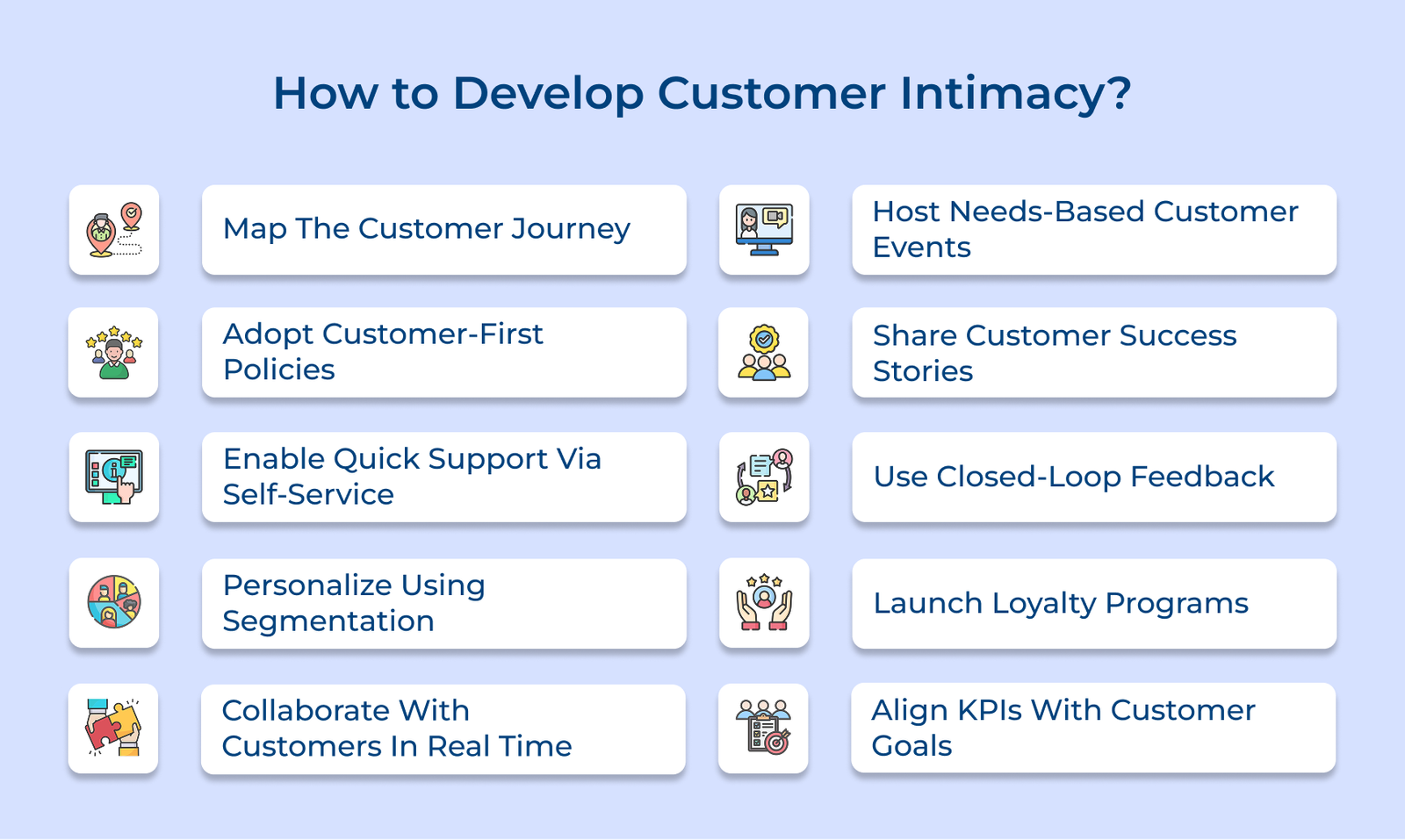
Understanding your customer journey is essential for building customer intimacy. It involves mapping every touchpoint, from initial awareness to post-purchase interactions. Using journey mapping tools, you can visualize the entire experience, pinpointing pain points, highlights and areas for improvement.
A well-crafted customer journey map offers a clear view of your business through the customer’s lens, uncovering insights that might be missed otherwise. The comprehensive perspective helps you optimize each stage, ensuring a seamless experience that enhances loyalty and strengthens relationships.
Actionable tips:
Creating customer-centric policies is key to building consumer intimacy. Start by reviewing existing policies to pinpoint friction points for customers. Involve them in crafting new policies to ensure their needs are prioritized.
The policies should emphasize flexibility and be communicated to both customers along with staff. Consistent enforcement across all departments is essential. Regularly update policies based on customer feedback and market changes to keep them relevant.
Pro tips:
Enhance customer intimacy by offering prompt service through a self-service portal. An intuitive knowledge base allows customers to quickly find answers, boosting satisfaction and easing your support team’s workload. About 88% of customers state they want access to a self-service portal when shopping online.
Integrating chatbot support can further streamline the process. The AI assistants handle routine inquiries, provide instant responses and escalate complex issues to human agents when needed. Customers can get help anytime with 24/7 access, regardless of time zones or business hours.
Best Practices:
Personalizing your approach through customer segmentation is a powerful way to cultivate intimacy. Start by analyzing customer data to uncover insights into their behaviors, preferences and needs. Create detailed personas from the information that represent the various segments of your target audience.
Businesses can tailor their communications and offerings to resonate with each segment’s specific interests with the personas in hand. The personalization shows customers that you truly understand and value their unique needs, enhancing a deeper connection with your brand.
Actionable tips:
Real-time collaboration is key to building strong customer relationships and enhancing intimacy. Utilize collaborative tools like project management software, shared document repositories and dedicated customer portals to facilitate seamless communication.
Encourage open communication by establishing regular check-ins and multiple feedback channels, including live chat for instant support. The collaborative approach allows you to closely engage with customers, addressing their needs, solving problems and co-creating solutions together.
Actionable tips:
Hosting customer-focused events is a powerful way to strengthen relationships and showcase your commitment to their success. Begin by assessing your customers’ challenges and goals to tailor industry-specific workshops or seminars that meet their needs.
The events enhance face-to-face interaction, knowledge sharing and networking, positioning your company as a thought leader. You ensure attendees gain real value by emphasizing educational content and practical solutions, further building trust.
Actionable tips:
Creating case studies that showcase your customers’ success stories is a powerful way to build credibility and demonstrate the impact of your products or services. Highlight how your solutions have helped clients overcome challenges and achieve their goals.
Focus on measurable results, using concrete data and metrics to illustrate the transformation. The approach not only offers social proof for potential clients but also reinforces your value to existing customers, deepening their trust and loyalty.
Actionable tips:
Implementing a closed-loop feedback system is vital for enhancing customer intimacy. It involves systematically gathering feedback at key touch points throughout the customer journey, using both solicited methods (like surveys, interviews) and unsolicited channels (such as social media, support tickets).
Success lies not just in collecting feedback but in acting on it swiftly. Establish processes to analyze insights, identify trends and make changes based on customer input. Regularly update customers on how their feedback is being utilized, reinforcing that you value their opinions and are dedicated to improving their experience.
Pro tips:
Customer loyalty programs are a powerful way to reward and retain your most valuable clients, nurturing long-term relationships. 75% of consumers will favor a brand if there is a loyalty program. Create tiered reward systems that provide increasing benefits as customers deepen their engagement, motivating them to stay loyal.
Go beyond simple discounts by offering exclusive perks like early access to new products, personalized services or special events. Celebrate customer milestones with personalized gestures, such as anniversaries or spending achievements. The thoughtful touches show that you truly value their loyalty and relationship with your brand.
Pro tips:
Align your key performance indicators (KPIs) with customer-centric goals to truly cultivate customer intimacy. Focus on metrics that reflect satisfaction, loyalty or value, such as Net Promoter Score (NPS), Customer Lifetime Value (CLV) and Customer Effort Score (CES).
Once you’ve identified the metrics, adjust performance evaluations and incentives to prioritize customer success across all departments. Regularly review and update these KPIs to ensure they remain relevant to your evolving intimacy goals.
Actionable tips:
Cultivating brand evangelists and influencers can greatly enhance customer intimacy. Start by identifying your most satisfied customers, those who are passionate about your brand and eager to share their positive experiences.
Launch ambassador programs that offer the advocates exclusive perks, insider info and a role in shaping product development. Equip them with resources like shareable content, product samples and training on your latest offerings. You create a network of authentic voices that boost your brand’s credibility and appeal by empowering the evangelists.
Actionable tips:
Let’s explore essential metrics you should consider to help deepen your understanding of customer intimacy and strengthen the bonds that lead to lasting loyalty.
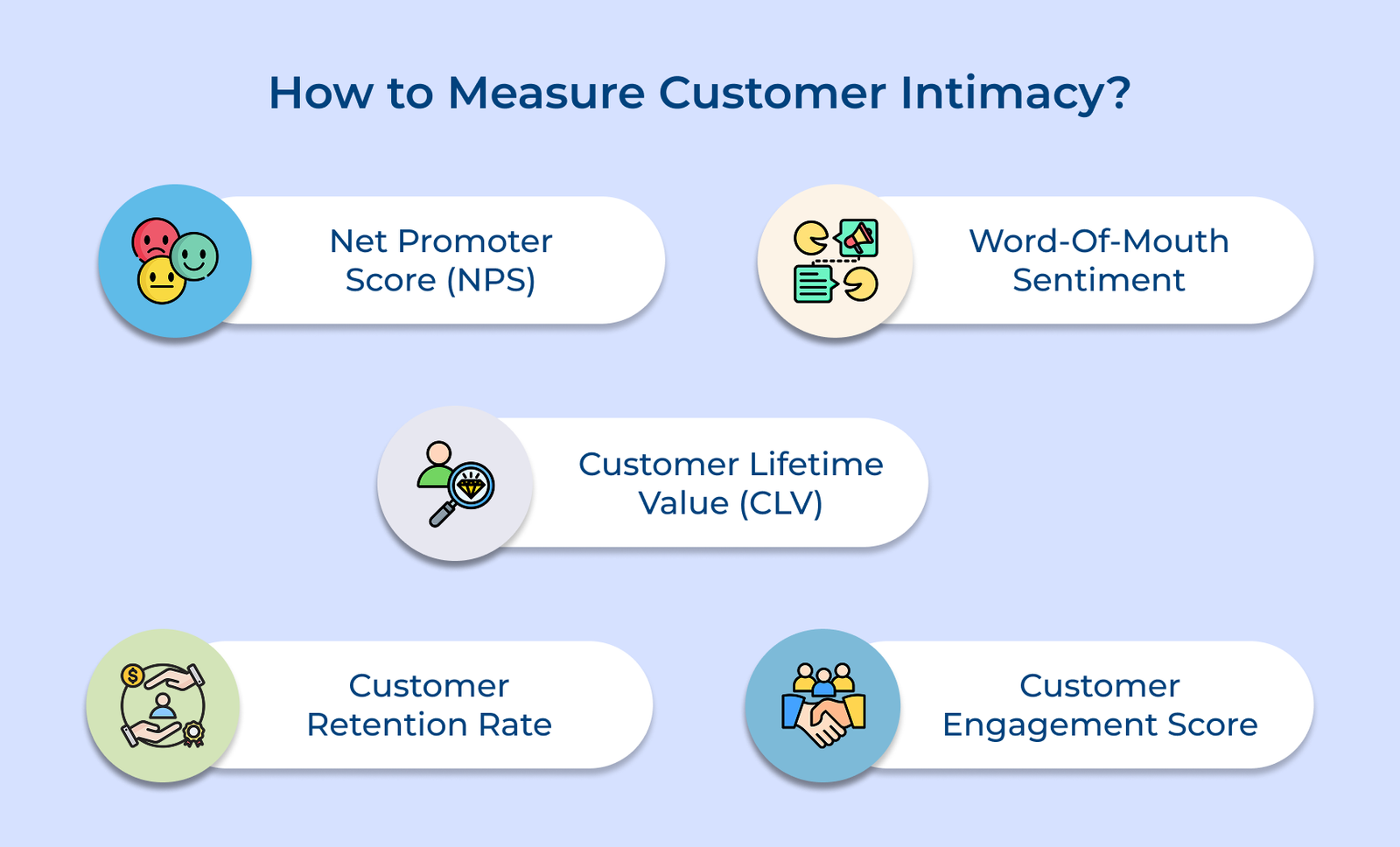
1. Net Promoter Score (NPS)
NPS gauges customer loyalty and their likelihood to recommend a company. Customers rate their willingness on a scale from 0 to 10, categorized as Promoters (9-10), Passives (7-8) or Detractors (0-6). The NPS is calculated by subtracting the percentage of Detractors from Promoters. A high NPS signals strong customer relationships and loyalty, showcasing effective customer intimacy.
2. Word-of-mouth sentiment
The metric assesses the tone or content of customer conversations about a brand on platforms like social media, review sites and forums. Companies can measure overall sentiment by monitoring mentions, comments and shares. Positive word-of-mouth reflects strong customer relationships and brand advocacy, while negative sentiment reveals areas needing improvement in consumer intimacy.
3. Customer Lifetime Value (CLV)
CLV estimates the total revenue a customer is expected to generate throughout their relationship with a company. It considers factors such as purchase frequency, average order value and customer lifespan. A high Customer Lifetime Value (CLV) signals strong customer intimacy, reflecting repeated purchases and rising spending.
4. Customer Retention Rate
The metric tracks the percentage of customers retained over a specific period. A high retention rate indicates strong customer relationships and satisfaction, showcasing effective intimacy efforts. Compare the number of customers at the start and end of the period to calculate it, factoring in new acquisitions. Improved retention typically reflects deeper customer intimacy.
5. Customer Engagement Score
The composite metric blends multiple indicators of customer interaction, including purchase frequency, customer service engagement, loyalty program participation, social media activity and product usage. A high and rising engagement score signifies strong customer intimacy, reflecting active involvement and investment in the company’s offerings.
Check out the key challenges businesses face in their journey towards enhancing customer intimacy and offer insights on how to overcome them effectively.
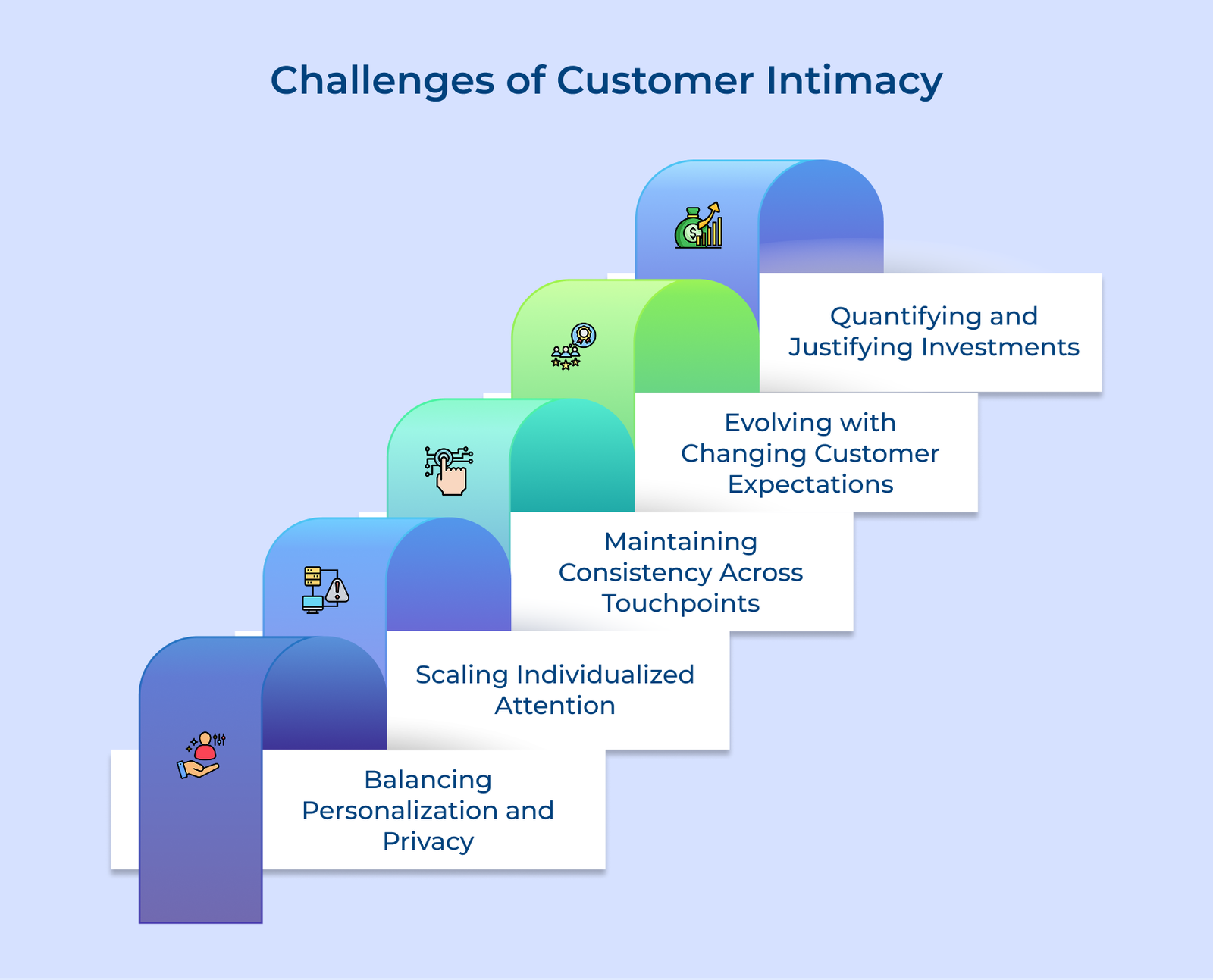
Customers value personalized experiences but are increasingly wary of data privacy. Companies must balance collecting customer data for tailored services with respecting privacy boundaries. Intrusive data practices or misuse of personal information can quickly undermine trust and harm relationships.
Delivering personalized, high-touch service to a growing customer base can strain resources. As companies expand, maintaining individual attention becomes challenging. Firms must harness technology and streamline processes while still keeping that essential human touch to preserve genuine customer intimacy.
Customers engage with brands across various platforms and devices. Delivering a consistent, intimate experience at every touchpoint is challenging. Fragmented data, siloed teams and mixed messaging can create disjointed journeys that hinder intimacy efforts.
Customer needs and preferences are ever-changing. What feels intimate today may fall short tomorrow. Companies must consistently adapt strategies, retrain staff and update technologies to maintain strong connections.
Investing in consumer intimacy initiatives demands substantial upfront costs for technology, training and process redesigns, making it hard to measure returns accurately. Executives may find it challenging to justify the expenses amid competing priorities with clearer short-term benefits.
Check out the best practices that can bridge the gap between your brand and the customers, transforming mere interactions into meaningful relationships.
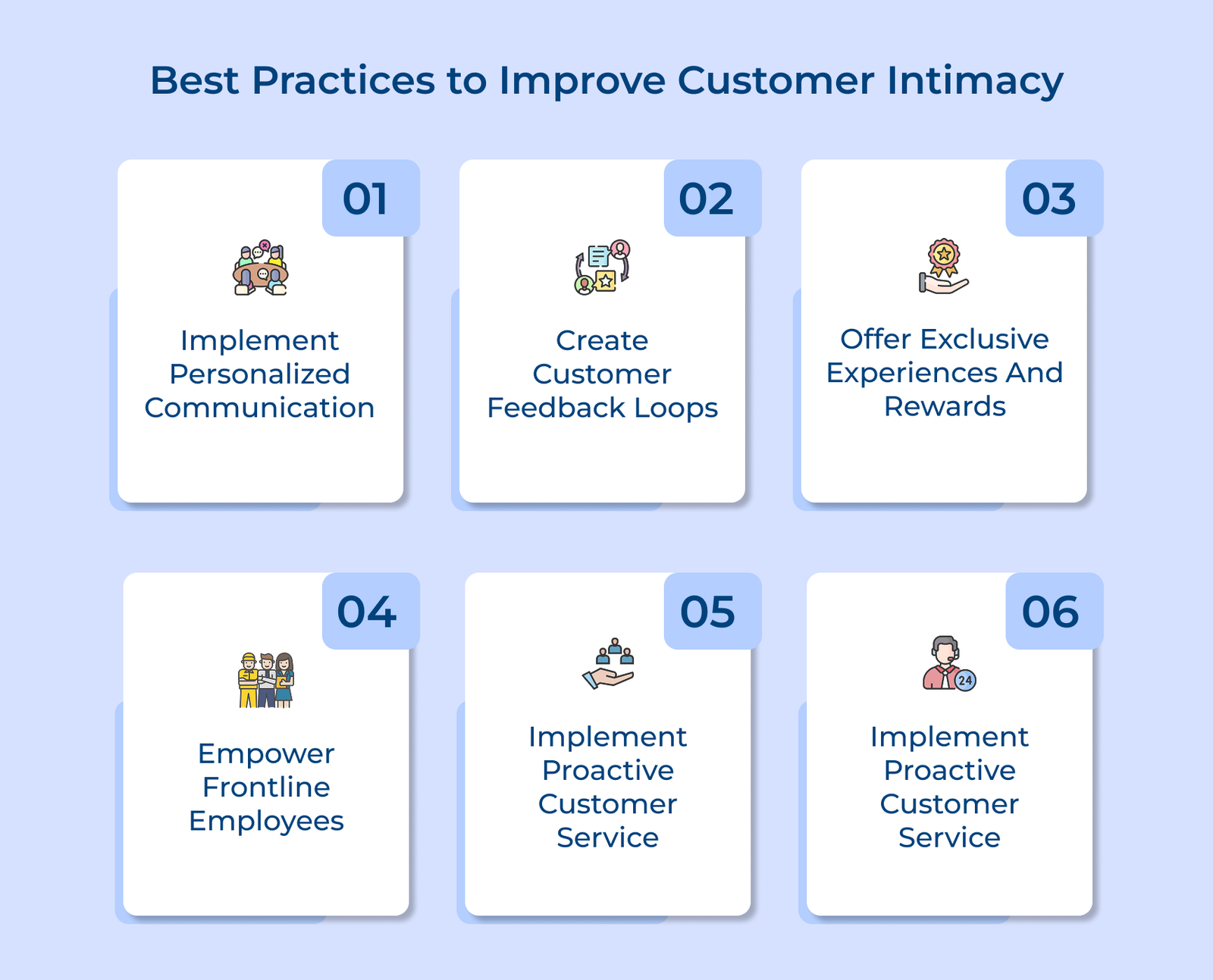
Leverage data analytics to grasp individual customer preferences and tailor your messaging. Implement a system that tracks interactions across all touchpoints, ensuring consistent, personalized experiences. 76% of customers said personalized messages were essential in enhancing their consideration of a brand.
Continuously act on customer feedback through surveys, focus groups and direct conversations. Create a dedicated team to analyze this feedback and drive improvements. You reinforce their vital role in your business by showcasing how customer input shapes your products or services.
Create a tiered loyalty program that rewards customers with escalating benefits as they engage more with your brand. Offer exclusive events, early product access or behind-the-scenes tours for your top supporters. The unique experiences foster emotional connections and show customers they are truly valued.
Empower your customer-facing staff to make decisions that prioritize customer satisfaction without needing constant management approval. Equip them with the tools and authority to resolve issues swiftly. The approach demonstrates your organization’s commitment to customer happiness and enhances trust.
Proactively anticipate customer needs and tackle potential issues before they escalate. Leverage predictive analytics to identify at-risk customers and engage them with personalized retention offers. Regular check-ins ensure ongoing satisfaction, showcasing your dedication to their success.
Engage select customers in your innovation journey through co-creation workshops or beta testing programs. The approach offers valuable insights while giving customers a sense of ownership. You deepen their emotional investment in your brand by publicly acknowledging their contributions.
Join us as we explore compelling examples of customer intimacy that can serve as blueprints for your business success.
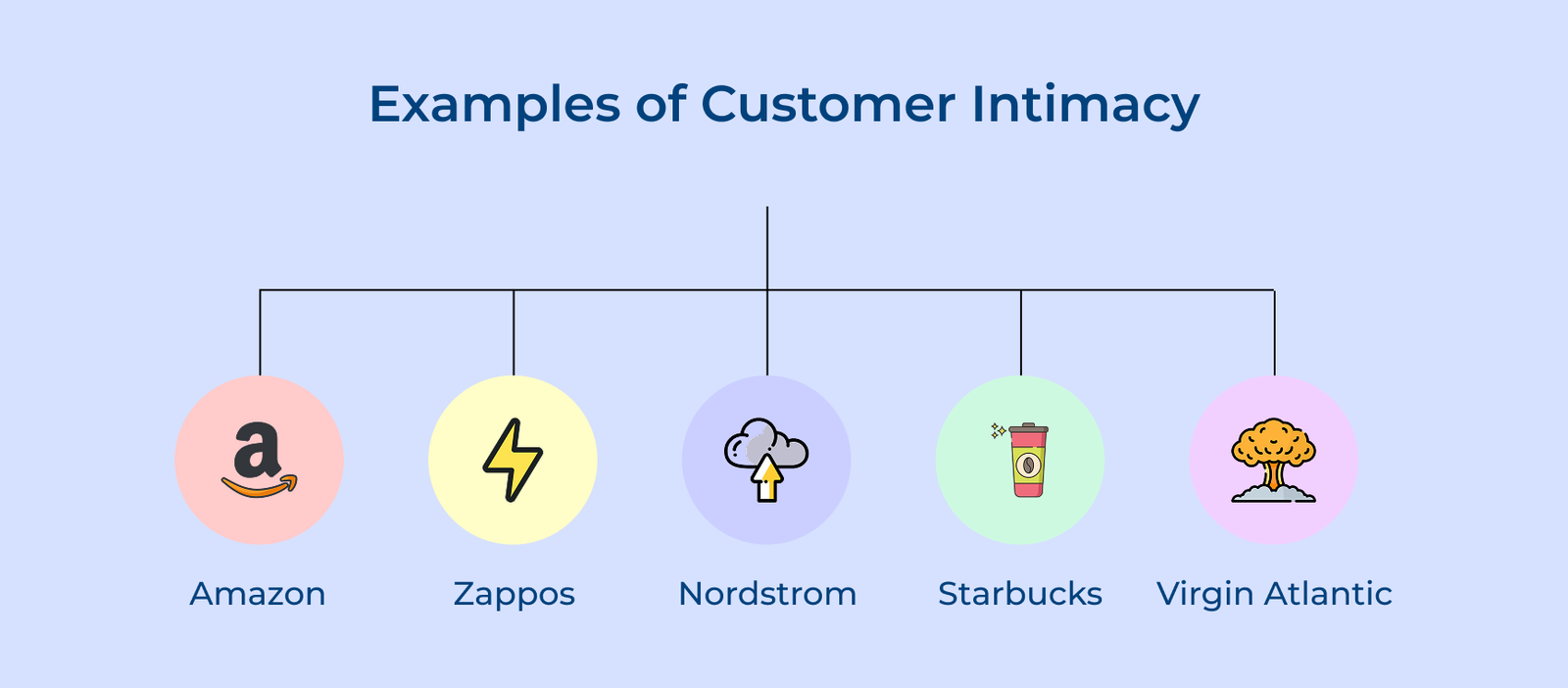
1. Amazon
Amazon has revolutionized customer intimacy by delivering a personalized shopping experience tailored to each user through smart product recommendations based on their browsing and purchase history. The customization not only enhances user satisfaction but also drives engagement.
Their commitment to a customer-centric approach is exemplified in the Prime membership, which provides fast shipping, streaming services and exclusive deals. Amazon strengthens long-term relationships with a focus on exceptional customer service including hassle-free returns and 24/7 support, ensuring that customers feel valued by the brand.
2. Zappos
Zappos has earned a stellar reputation for exceptional customer service, going the extra mile to build personal connections. Their representatives often spend hours on a single call, ensuring that every customer leaves satisfied.
Zappos prioritizes customer convenience with a generous 365-day return policy and free shipping both ways. They also empower employees to make decisions that benefit the customer, even if it means bending the rules, reinforcing their commitment to a truly remarkable shopping experience.
3. Nordstrom
Nordstrom’s exceptional customer service is a defining aspect of its brand. The company empowers employees to exercise their best judgment, resulting in legendary stories of outstanding service.
One notable instance involved Nordstrom accepting a return of tires, despite not selling them. The customer-first mentality enhances deep loyalty, making customers feel truly valued and understood by the brand.
4. Starbucks
Starbucks excels at personalizing the coffee experience. Their mobile app lets customers order ahead, customize drinks and earn rewards, making each visit tailored to individual preferences.
Baristas are trained to remember regulars’ names and orders, fostering a welcoming atmosphere. Starbucks shows a genuine commitment to evolving alongside its customers’ needs by actively seeking customer feedback and implementing changes.
5. Virgin Atlantic
Virgin Atlantic shines with its commitment to customer intimacy. The airline enhances the flying experience with personalized in-flight entertainment, customizable mood lighting and attentive service from staff who anticipate passenger needs.
Their Flying Club frequent flyer program tailors rewards and experiences to individual preferences, enhancing loyalty. Virgin Atlantic also actively engages with customers on social media, addressing concerns and celebrating positive experiences in real-time, reinforcing their dedication to customer connection.
Customer intimacy strategies play a pivotal role in crafting personalized experiences that truly resonate with individual customers. The approach enhances loyalty and nurtures long-term relationships, setting companies apart from their rivals.
Businesses can boost profitability through higher customer retention and increased transaction values by embracing the strategies. Focusing resources on their most valuable customers not only enhances operational efficiency but also deepens client engagement. It makes the customers feel understood, driving stronger brand advocacy and encouraging word-of-mouth referrals.
Customer intimacy sets itself apart from operational excellence and product leadership by prioritizing personalized solutions over standardization or innovation. While operational excellence aims for efficiency and product leadership showcases cutting-edge offerings, customer intimacy focuses on delivering exceptional service to meet specific customer needs.
Technology is essential for enhancing customer intimacy. Customer relationship management (CRM) systems help businesses organize and analyze data for more personalized interactions. Social media platforms enable direct engagement, enhancing real-time communication and feedback. Marketing automation tools deliver tailored content and offers based on customer behavior, creating a more customized experience.
Customer intimacy depends on data, but reputable companies prioritize data privacy and security. They maintain transparency about data collection and usage, complying with regulations like GDPR. Remember, you have control over what data you share and how it’s used, so always review privacy policies.
ROI for customer intimacy can be gauged using several key metrics, such as customer lifetime value, retention rates, Net Promoter Score and average transaction value. Monitor engagement metrics, repeat purchase rates and customer acquisition costs. Long-term revenue growth and market share expansion reflect the success of your strategies.

Market better, sell faster and support smarter with Veemo’s Conversation Customer Engagement suite of products.
Unify all your customer data in one platform to deliver contextual responses. Get a 360 degree view of the customer lifecycle without switching tools.
Connect with the tools you love to reduce manual activities and sync your business workflows for a seamless experience.
 https://veemo.io/wp-content/uploads/2024/12/customer-service-response-time.png
1256
2400
Webvision Solution
https://veemo.io/wp-content/uploads/2024/11/veemo.svg
Webvision Solution2025-10-17 10:51:142025-10-17 10:51:149 Effective Tips to Reduce Customer Service Response Time
https://veemo.io/wp-content/uploads/2024/12/customer-service-response-time.png
1256
2400
Webvision Solution
https://veemo.io/wp-content/uploads/2024/11/veemo.svg
Webvision Solution2025-10-17 10:51:142025-10-17 10:51:149 Effective Tips to Reduce Customer Service Response Time https://veemo.io/wp-content/uploads/2024/10/How-to-Create-Knowledge-Base.png
1257
2400
Vikas Sachan
https://veemo.io/wp-content/uploads/2024/11/veemo.svg
Vikas Sachan2024-10-21 12:24:342025-11-03 07:13:21How to Create a Knowledge Base in 9 Easy Steps: The Ultimate Guide
https://veemo.io/wp-content/uploads/2024/10/How-to-Create-Knowledge-Base.png
1257
2400
Vikas Sachan
https://veemo.io/wp-content/uploads/2024/11/veemo.svg
Vikas Sachan2024-10-21 12:24:342025-11-03 07:13:21How to Create a Knowledge Base in 9 Easy Steps: The Ultimate Guide https://veemo.io/wp-content/uploads/2024/02/Live-Chat-for-Sales.png
628
1200
teamwebvisionsolution@gmail.com
https://veemo.io/wp-content/uploads/2024/11/veemo.svg
teamwebvisionsolution@gmail.com2024-10-21 11:31:222025-08-06 10:22:06How to Use Live Chat for Sales? 7 Proven Ways to Grow Revenue
https://veemo.io/wp-content/uploads/2024/02/Live-Chat-for-Sales.png
628
1200
teamwebvisionsolution@gmail.com
https://veemo.io/wp-content/uploads/2024/11/veemo.svg
teamwebvisionsolution@gmail.com2024-10-21 11:31:222025-08-06 10:22:06How to Use Live Chat for Sales? 7 Proven Ways to Grow RevenueGrow Customer Relationships and stronger team collaboration with our range of products across the Conversational Engagement Suite.

 What is a Customer Experience Team: Structure & Best Practices
Scroll to top
What is a Customer Experience Team: Structure & Best Practices
Scroll to top